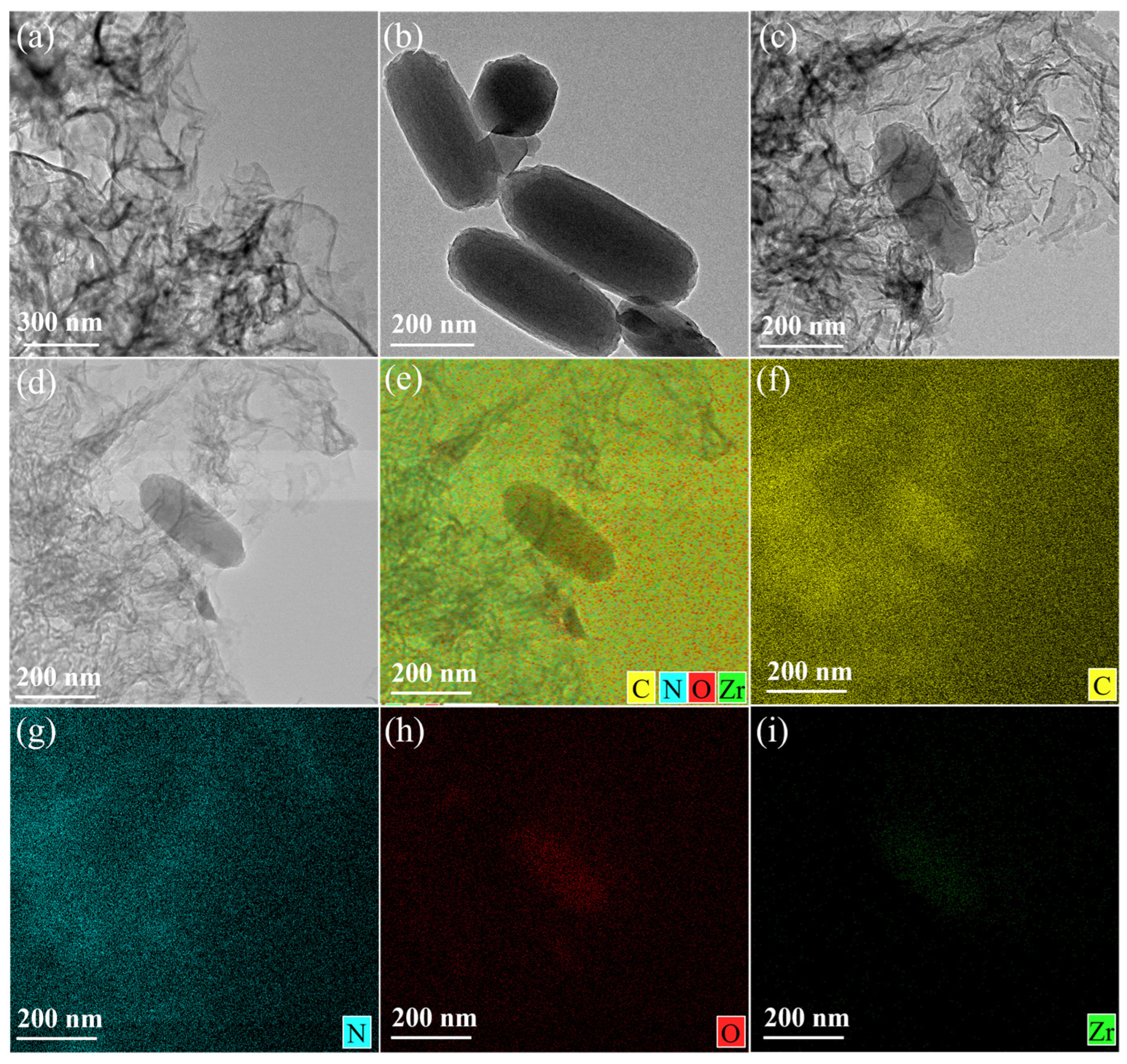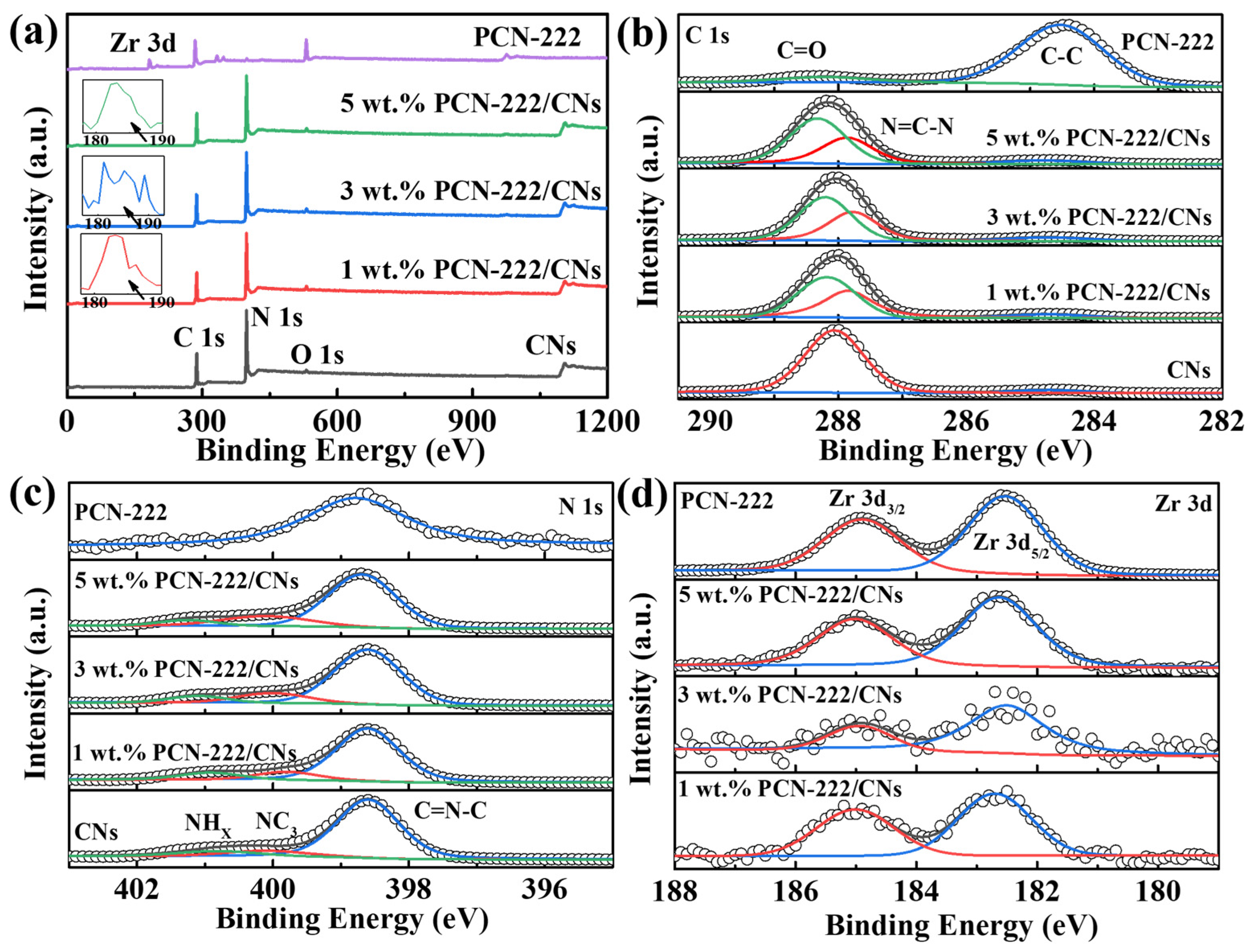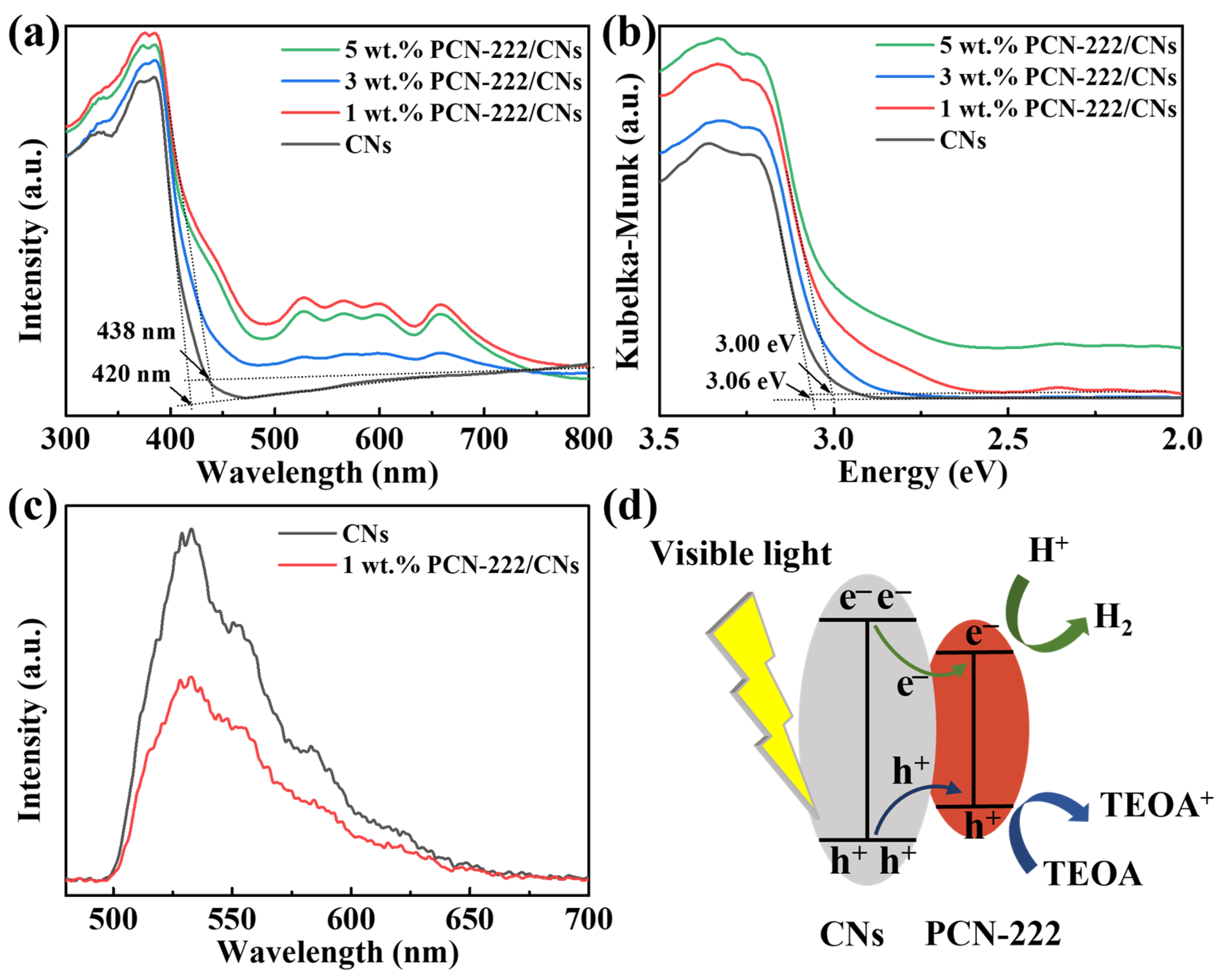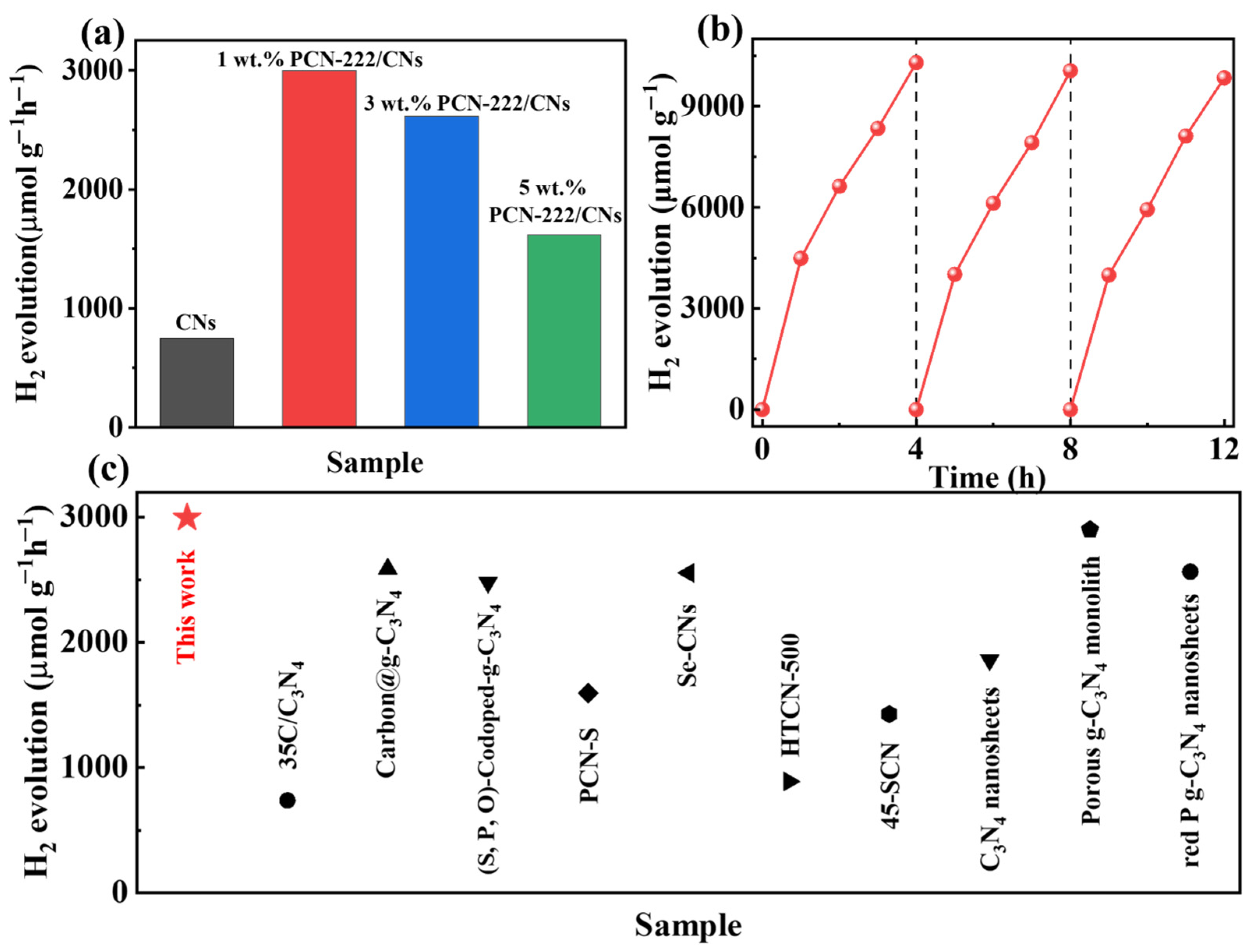Construction of PCN-222 and Atomically Thin 2D CNs Van Der Waals Heterojunction for Enhanced Visible Light Photocatalytic Hydrogen Production
Abstract
1. Introduction
2. Materials and Methods
2.1. Materials
2.2. Synthesis of Atomically Thin 2D CNs
2.3. Synthesis of PCN-222
2.4. Synthesis of PCN-222/CNs Van Der Waals Heterojunction
2.5. Characterization
2.6. Photocatalytic Activity Measurement
3. Results and Discussions
4. Conclusions
Author Contributions
Funding
Data Availability Statement
Conflicts of Interest
References
- Swift, E. A durable semiconductor photocatalyst. Science 2019, 365, 320–321. [Google Scholar] [CrossRef] [PubMed]
- Chen, J.; Kang, N.; Fan, J.; Lu, C.; Lv, K. Carbon nitride for photocatalytic water splitting to produce hydrogen and hydrogen peroxide. Mater. Today Chem. 2022, 26, 101028. [Google Scholar] [CrossRef]
- Li, Q.; Chen, C.; Li, C.; Liu, R.; Bi, S.; Zhang, P.; Zhou, Y.; Mai, Y. Ordered Bicontinuous Mesoporous Polymeric Semiconductor Photocatalyst. ACS Nano 2020, 14, 13652–13662. [Google Scholar] [CrossRef] [PubMed]
- Friedmann, D.; Lee, A.F.; Wilson, K.; Jalili, R.; Caruso, R.A. Printing approaches to inorganic semiconductor photocatalyst fabrication. J. Mater. Chem. A 2019, 7, 10858–10878. [Google Scholar] [CrossRef]
- Wang, X.; Maeda, K.; Thomas, A.; Takanabe, K.; Xin, G.; Carlsson, J.M.; Domen, K.; Antonietti, M. A metal-free polymeric photocatalyst for hydrogen production from water under visible light. Nat. Mater. 2009, 8, 76–80. [Google Scholar] [CrossRef]
- Nguyen, P.A.; Nguyen, T.K.A.; Dao, D.Q.; Shin, E.W. Ethanol Solvothermal Treatment on Graphitic Carbon Nitride Materials for Enhancing Photocatalytic Hydrogen Evolution Performance. Nanomaterials 2022, 12, 179. [Google Scholar] [CrossRef]
- Ruan, X.; Cui, X.; Jia, G.; Wu, J.; Zhao, J.; Singh, D.J.; Liu, Y.; Zhang, H.; Zhang, L.; Zheng, W. Intramolecular heterostructured carbon nitride with heptazine-triazine for enhanced photocatalytic hydrogen evolution. Chem. Eng. J. 2022, 428, 132579. [Google Scholar] [CrossRef]
- Sun, Z.; Fischer, J.M.T.A.; Li, Q.; Hu, J.; Tang, Q.; Wang, H.; Wu, Z.; Hankel, M.; Searles, D.J.; Wang, L. Enhanced CO2 photocatalytic reduction on alkali-decorated graphitic carbon nitride. Appl. Catal. B 2017, 216, 146–155. [Google Scholar] [CrossRef]
- Indra, A.; Beltran-Suito, R.; Muller, M.; Sivasankaran, R.P.; Schwarze, M.; Acharjya, A.; Pradhan, B.; Hofkens, J.; Bruckner, A.; Thomas, A.; et al. Promoting Photocatalytic Hydrogen Evolution Activity of Graphitic Carbon Nitride with Hole-Transfer Agents. ChemSusChem 2021, 14, 306–312. [Google Scholar] [CrossRef]
- Yu, X.; Su, H.; Zou, J.; Liu, Q.; Wang, L.; Tang, H. Doping-induced metal–N active sites and bandgap engineering in graphitic carbon nitride for enhancing photocatalytic H2 evolution performance. Chin. J. Catal. 2022, 43, 421–432. [Google Scholar] [CrossRef]
- Palani, G.; Apsari, R.; Hanafiah, M.M.; Venkateswarlu, K.; Lakkaboyana, S.K.; Kannan, K.; Shivanna, A.T.; Idris, A.M.; Yadav, C.H. Metal-Doped Graphitic Carbon Nitride Nanomaterials for Photocatalytic Environmental Applications—A Review. Nanomaterials 2022, 12, 1754. [Google Scholar] [CrossRef]
- Xue, M.; Jiang, D.; Du, H.; Li, Z.; Bi, H.; Yuan, Y. Atomic-level localization of π-electrons in defect engineered tri-s-triazine units for increased photocatalytic hydrogen generation of polymeric carbon nitride. Catal. Sci. Technol. 2021, 11, 5663–5670. [Google Scholar] [CrossRef]
- Lin, L.; Yu, Z.; Wang, X. Crystalline Carbon Nitride Semiconductors for Photocatalytic Water Splitting. Angew. Chem. Int. Ed. 2019, 58, 6164–6175. [Google Scholar] [CrossRef]
- Wang, Y.; Zeng, C.; Wu, L.; Dong, Y.; Zhang, Y.; Yang, D.; Hu, W.; Hao, J.; Pan, H.; Yang, R. Constructing metal-free heterophotocatalyst using two-dimensional carbon nitride sheets and violet phosphorene for highly efficient visible-light photocatalysis. J. Mater. Sci. Technol. 2023, 146, 113–120. [Google Scholar] [CrossRef]
- Zhang, Y.; Wang, Y.; Xu, W.; Wu, Y.; Zeng, C.; Wang, Y.; Zhong, W.; Yang, R. Increased solar absorption and promoted photocarrier separation in atomically thin 2D carbon nitride sheets for enhanced visible-light photocatalysis. Chem. Eng. J. 2022, 431, 133219. [Google Scholar] [CrossRef]
- Yin, H.; Yuan, C.; Lv, H.; He, X.; Liao, C.; Liu, X.; Zhang, Y. Construction of Electrostatic Self-Assembled 2D/2D CdIn(2)S(4)/g-C(3)N(4) Heterojunctions for Efficient Visible-Light-Responsive Molecular Oxygen Activation. Nanomaterials 2021, 11, 2342. [Google Scholar] [CrossRef] [PubMed]
- Wang, Y.; Zhang, Y.; Wang, Y.; Zeng, C.; Sun, M.; Yang, D.; Cao, K.; Pan, H.; Wu, Y.; Liu, H.; et al. Constructing van der Waals Heterogeneous Photocatalysts Based on Atomically Thin Carbon Nitride Sheets and Graphdiyne for Highly Efficient Photocatalytic Conversion of CO(2) into CO. ACS Appl. Mater. Interfaces 2021, 13, 40629–40637. [Google Scholar] [CrossRef]
- Wang, Y.; Guo, Y.; Zeng, C.; Yang, D.; Zhang, Y.; Wu, L.; Wu, Y.; Hao, J.; Wang, J.; Yang, R. Realizing a strong visible-light absorption band in piezoelectric 2D carbon nitride sheets for enhanced piezocatalysis. Nano Energy 2022, 104, 107983. [Google Scholar] [CrossRef]
- Kumar, P.; Laishram, D.; Sharma, R.K.; Vinu, A.; Hu, J.; Kibria, M.G. Boosting Photocatalytic Activity Using Carbon Nitride Based 2D/2D van der Waals Heterojunctions. Chem. Mater. 2021, 33, 9012–9092. [Google Scholar] [CrossRef]
- Wang, Y.; Xu, W.; Zhang, Y.; Zeng, C.; Zhang, W.; Fu, L.; Sun, M.; Wu, Y.; Hao, J.; Zhong, W.; et al. Introducing Spin Polarization into Mixed-Dimensional Van der Waals Heterostructures for High-Efficiency Visible-Light Photocatalysis. Energy Environ. Mater. 2022, 0, 1–9. [Google Scholar] [CrossRef]
- Wang, Y.; Zeng, C.; Zhang, Y.; Su, R.; Yang, D.; Wang, Z.; Wu, Y.; Pan, H.; Zhu, W.; Hu, W.; et al. Promoted photocarriers separation by straining in 2D/2D van der Waals heterostructures for high-efficiency visible-light photocatalysis. Mater. Today Phys. 2022, 22, 100600. [Google Scholar] [CrossRef]
- Di Bartolomeo, A. Emerging 2D Materials and Their Van Der Waals Heterostructures. Nanomaterials 2020, 10, 579. [Google Scholar] [CrossRef]
- Qian, Y.; Zhang, F.; Pang, H. A Review of MOFs and Their Composites-Based Photocatalysts: Synthesis and Applications. Adv. Funct. Mater. 2021, 31, 2104231. [Google Scholar] [CrossRef]
- Xiao, Y.; Guo, X.; Yang, N.; Zhang, F. Heterostructured MOFs photocatalysts for water splitting to produce hydrogen. J. Energy Chem. 2021, 58, 508–522. [Google Scholar] [CrossRef]
- Wang, M.; Tang, Y.; Jin, Y. Modulating Catalytic Performance of Metal-Organic Framework Composites by Localized Surface Plasmon Resonance. ACS Catal. 2019, 9, 11502–11514. [Google Scholar] [CrossRef]
- Wang, Y.-M.; Xu, Y.; Zhang, X.; Cui, Y.; Liang, Q.; Liu, C.; Wang, X.; Wu, S.; Yang, R. Single Nano-Sized Metal-Organic Framework for Bio-Nanoarchitectonics with In Vivo Fluorescence Imaging and Chemo-Photodynamic Therapy. Nanomaterials 2022, 12, 287. [Google Scholar] [CrossRef] [PubMed]
- Yang, K.; Ye, J.; Zhao, Y.; Ge, K.; Cao, J.; Wang, S.; Zhang, Z.; Zhang, Y.; Yang, Y. IO-TiO2/PCN-222 Heterostructure with a Tightly Connected Interface and Its Photocatalytic Activity. ChemistrySelect 2021, 6, 4238–4246. [Google Scholar] [CrossRef]
- Wang, Y.; Du, P.; Pan, H.; Fu, L.; Zhang, Y.; Chen, J.; Du, Y.; Tang, N.; Liu, G. Increasing Solar Absorption of Atomically Thin 2D Carbon Nitride Sheets for Enhanced Visible-Light Photocatalysis. Adv. Mater. 2019, 31, e1807540. [Google Scholar] [CrossRef] [PubMed]
- Wang, P.; Ba, X.; Zhang, X.; Gao, H.; Han, M.; Zhao, Z.; Chen, X.; Wang, L.; Diao, X.; Wang, G. Direct Z-scheme heterojunction of PCN-222/CsPbBr3 for boosting photocatalytic CO2 reduction to HCOOH. Chem. Eng. J. 2023, 457, 141248. [Google Scholar] [CrossRef]
- Wang, Y.; Sun, M.; Tang, W.; Li, Q.; Ren, Z.; Liu, Y.; Zhang, Y.; Zeng, C.; Wang, Z.; Wu, Y.; et al. Realizing strong visible-light absorption band for 2D crystalline carbon nitride sheets induced by extending π-conjugation and introducing cyano groups. Mater. Today Phys. 2022, 23, 100634. [Google Scholar] [CrossRef]
- Zhang, G.Y.; Zhuang, Y.H.; Shan, D.; Su, G.F.; Cosnier, S.; Zhang, X.J. Zirconium-Based Porphyrinic Metal-Organic Framework (PCN-222): Enhanced Photoelectrochemical Response and Its Application for Label-Free Phosphoprotein Detection. Anal. Chem. 2016, 88, 11207–11212. [Google Scholar] [CrossRef]
- Green, M.; Liu, Z.; Smedley, R.; Nawaz, H.; Li, X.; Huang, F.; Chen, X. Graphitic carbon nitride nanosheets for microwave absorption. Mater. Today Phys. 2018, 5, 78–86. [Google Scholar] [CrossRef]
- Wang, Y.; Zeng, C.; Liu, Y.; Yang, D.; Zhang, Y.; Ren, Z.; Li, Q.; Hao, J.; Hu, W.; Wu, Y.; et al. Constructing Heterogeneous Photocatalysts Based on Carbon Nitride Nanosheets and Graphene Quantum Dots for Highly Efficient Photocatalytic Hydrogen Generation. Materials 2022, 15, 5390. [Google Scholar] [CrossRef] [PubMed]
- Dong, W.; Li, Z.; Wen, W.; Feng, S.; Zhang, Y.; Wen, G. PCN-222@g-C(3)N(4) cathodic materials for "signal-off" photoelectrochemical sensing of kanamycin sulfate. RSC Adv. 2021, 11, 28320–28325. [Google Scholar] [CrossRef]
- Feng, D.; Gu, Z.Y.; Li, J.R.; Jiang, H.L.; Wei, Z.; Zhou, H.C. Zirconium-metalloporphyrin PCN-222: Mesoporous metal-organic frameworks with ultrahigh stability as biomimetic catalysts. Angew. Chem. Int. Ed. 2012, 51, 10307–10310. [Google Scholar] [CrossRef]
- Jia, H.; Ma, D.; Zhong, S.; Li, L.; Li, L.; Xu, L.; Li, B. Boosting photocatalytic activity under visible-light by creation of PCN-222/g-C3N4 heterojunctions. Chem. Eng. J. 2019, 368, 165–174. [Google Scholar] [CrossRef]
- Hong, Y.; Liu, E.; Shi, J.; Lin, X.; Sheng, L.; Zhang, M.; Wang, L.; Chen, J. A direct one-step synthesis of ultrathin g-C3N4 nanosheets from thiourea for boosting solar photocatalytic H2 evolution. Int. J. Hydrogen Energy 2019, 44, 7194–7204. [Google Scholar] [CrossRef]
- Biswas, S.; Chen, Y.; Xie, Y.; Sun, X.; Wang, Y. Ultrasmall Au(0) Inserted Hollow PCN-222 MOF for The High-Sensitive Detection of Estradiol. Anal. Chem. 2020, 92, 4566–4572. [Google Scholar] [CrossRef]
- Zhao, Z.; Fan, J.; Deng, X.; Liu, J. One-step synthesis of phosphorus-doped g-C3N4/Co3O4 quantum dots from vitamin B12 with enhanced visible-light photocatalytic activity for metronidazole degradation. Chem. Eng. J. 2019, 360, 1517–1529. [Google Scholar] [CrossRef]
- Yang, G.; Ding, H.; Chen, D.; Feng, J.; Hao, Q.; Zhu, Y. Construction of urchin-like ZnIn2S4-Au-TiO2 heterostructure with enhanced activity for photocatalytic hydrogen evolution. Appl. Catal. B 2018, 234, 260–267. [Google Scholar] [CrossRef]
- Lv, P.; Zhao, C.; Lee, W.J.; Huo, S.; Kwon, S.-H.; Fang, J.; Yang, Y. Less is more: Enhancement of photocatalytic activity of g-C3N4 nanosheets by site-selective atomic layer deposition of TiO2. Appl. Surf. Sci. 2019, 494, 508–518. [Google Scholar] [CrossRef]
- Ma, L.T.; Fan, H.Q.; Fu, K.; Lei, S.H.; Hu, Q.Z.; Huang, H.T.; He, G.P. Protonation of graphitic carbon nitride (g-C3N4) for an electrostatically self-assembling carbon@g-C3N4 core−shell nanostructure toward high hydrogen evolution. ACS Sustain. Chem. Eng. 2017, 5, 7093–7103. [Google Scholar] [CrossRef]
- Liu, Q.Q.; Shen, J.Y.; Yu, X.H.; Yang, X.F.; Liu, W.; Yang, J.; Tang, H.; Xu, H.; Li, H.M.; Li, Y.Y.; et al. Unveiling the origin of boosted photocatalytic hydrogen evolution in simultaneously (S, P, O)-codoped and exfoliated ultrathin g-C3N4 nanosheets. Appl. Catal. B Environ. 2017, 248, 84–94. [Google Scholar] [CrossRef]
- Ran, J.R.; Ma, T.Y.; Gao, G.P.; Du, X.W.; Qiao, S.Z. Porous P-Doped Graphitic Carbon Nitride Nanosheets for Synergistically Enhanced Visible-Light Photocatalytic H2 Production. Energy Environ. Sci. 2015, 8, 3708–3717. [Google Scholar] [CrossRef]
- Zhang, Y.; Wang, Y.; Di, M.Y.; Zhou, B.Y.; Xu, W.; Wu, N.D.; Wu, Y.Z.; Du, Y.W.; Zhong, W. Synergy of Dopants and Defects in Ultrathin 2D Carbon Nitride Sheets to Significantly boost the Photocatalytic Hydrogen Evolution. Chem. Eng. J. 2020, 385, 123938. [Google Scholar]
- Li, Y.; Gong, F.; Zhou, Q.; Feng, X.; Fan, J.; Xiang, Q. Crystalline isotype heptazine-/triazine-based carbon nitride heterojunctions for an improved hydrogen evolution. Appl. Catal. B Environ. 2020, 268, 118381. [Google Scholar] [CrossRef]
- Wang, H.; Zhao, Y.; Zhan, X.; Yu, J.; Chen, L.; Sun, Y.; Shi, H. Calcination synthesis of tin niobate loaded porous carbon nitride S-scheme heterojunction for photocatalytic H2 production and tetracycline degradation. J. Alloys Compd. 2022, 899, 163250. [Google Scholar] [CrossRef]
- Yang, S.; Gong, Y.; Zhang, J.; Zhan, L.; Ma, L.; Fang, Z.; Vajtai, R.; Wang, X.; Ajayan, P.M. Exfoliated Graphitic Carbon Nitride Nanosheets as Efficient Catalysts for Hydrogen Evolution under Visible Light. Adv. Mater. 2013, 25, 2452–2456. [Google Scholar] [CrossRef]
- Liang, Q.; Li, Z.; Yu, X.; Huang, Z.-H.; Kang, F.; Yang, Q.-H. Macroscopic 3D Porous Graphitic Carbon Nitride Monolith for Enhanced Photocatalytic Hydrogen Evolution. Adv. Mater. 2015, 27, 4634–4639. [Google Scholar] [CrossRef]
- Jing, L.; Zhu, R.; Phillips, D.L.; Yu, J.C. Effective Prevention of Charge Trapping in Graphitic Carbon Nitride with Nanosized Red Phosphorus Modification for Superior Photo(Electro)Catalysis. Adv. Funct. Mater. 2017, 27, 1703484. [Google Scholar] [CrossRef]




Disclaimer/Publisher’s Note: The statements, opinions and data contained in all publications are solely those of the individual author(s) and contributor(s) and not of MDPI and/or the editor(s). MDPI and/or the editor(s) disclaim responsibility for any injury to people or property resulting from any ideas, methods, instructions or products referred to in the content. |
© 2023 by the authors. Licensee MDPI, Basel, Switzerland. This article is an open access article distributed under the terms and conditions of the Creative Commons Attribution (CC BY) license (https://creativecommons.org/licenses/by/4.0/).
Share and Cite
Wu, L.; Mi, X.; Wang, S.; Huang, C.; Zhang, Y.; Wang, Y.-M.; Wang, Y. Construction of PCN-222 and Atomically Thin 2D CNs Van Der Waals Heterojunction for Enhanced Visible Light Photocatalytic Hydrogen Production. Nanomaterials 2023, 13, 1318. https://doi.org/10.3390/nano13081318
Wu L, Mi X, Wang S, Huang C, Zhang Y, Wang Y-M, Wang Y. Construction of PCN-222 and Atomically Thin 2D CNs Van Der Waals Heterojunction for Enhanced Visible Light Photocatalytic Hydrogen Production. Nanomaterials. 2023; 13(8):1318. https://doi.org/10.3390/nano13081318
Chicago/Turabian StyleWu, Liting, Xuke Mi, Shaopeng Wang, Can Huang, Yu Zhang, Yong-Mei Wang, and Yong Wang. 2023. "Construction of PCN-222 and Atomically Thin 2D CNs Van Der Waals Heterojunction for Enhanced Visible Light Photocatalytic Hydrogen Production" Nanomaterials 13, no. 8: 1318. https://doi.org/10.3390/nano13081318
APA StyleWu, L., Mi, X., Wang, S., Huang, C., Zhang, Y., Wang, Y.-M., & Wang, Y. (2023). Construction of PCN-222 and Atomically Thin 2D CNs Van Der Waals Heterojunction for Enhanced Visible Light Photocatalytic Hydrogen Production. Nanomaterials, 13(8), 1318. https://doi.org/10.3390/nano13081318







